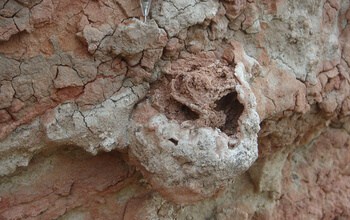Scientists have discovered the oldest fossil evidence of agriculture — not by humans, but by insects.
The team, led by Eric Roberts of James Cook University along with researchers from Ohio University, discovered the oldest known examples of “fungus gardens” in 25 million-year-old fossil termite nests in East Africa.
The results are published today in the journal PLOS ONE.
Some termite species cultivate fungi in “gardens” in subterranean nests or chambers, helping to convert plant material into a more easily digestible termite food source.
Scientists had previously used DNA from modern termites to estimate that termite fungus farming began 25 to 30 million years ago. The fossil evidence from Tanzania confirmed that date, allowing researchers to more accurately characterize the timing and evolution of the symbiotic relationship between termites and fungi. The relationship likely significantly modified the environment, scientists say.
“The origin of this behavior likely had a profound effect on how nutrients were concentrated across the landscape, influencing the evolution of Africa’s biota,” said study co-author Nancy Stevens of Ohio University.
“Since some 90 percent of the wood in the dry environment studied is digested by termites, understanding the development of this symbiotic relationship is important to our knowledge of the history of carbon cycling in this region,” said Paul Filmer, program director in the National Science Foundation (NSF) Directorate for Geosciences, which funded the research.
The transition to fungus agriculture increased the range of possible habitats for both the fungus-growing termites and their domesticated fungi. It’s a process similar to what happened tens of millions of years later with humans and domesticated crops and livestock, said study co-author Duur Aanen of Wageningen University in the Netherlands.
“This study emphasizes the need for integrating perspectives from the fossil record with modern approaches in comparative biology — it’s a holistic approach to evolutionary biology and increases our understanding of environmental change in ‘deep time,'” said scientist Patrick O’Connor of Ohio University, also a study co-author.
The African rain forest may have served as the cradle of termite agriculture. The transition to fungiculture helped termites disperse to less hospitable dry savannas, and eventually to migrate out of Africa and into Asia.
“The phenomenon might have been triggered by the development of the Great Rift Valley and the transformation of the landscape around that time,” Roberts said.
The study is part of an ongoing research project on the evolution of the Rukwa Rift Basin in Tanzania.
The research was also funded by James Cook University, Ohio University, the National Geographic Society, the Portuguese Foundation for Science and Fellowship, and a Marie Curie Fellowship.


